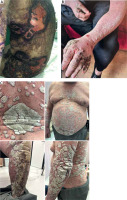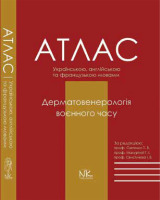One year after the Russian invasion of Ukraine, the military conflict continues to have a devastating effect on all aspects of human life. Recent United Nations data have shown that since the beginning of the war, more than 7199 Ukrainian civilians have been killed and 11,756 have been injured, with most casualties caused by explosive weapons. It is also suspected that the real number of causalities is much higher because precise data are difficult to obtain, especially from regions in which there is heavy fighting [1]. It is obvious that the war affects the healthcare system, resulting in limited access to medical care and a shortage of drugs and devices, causing many challenging situations both for patients and physicians. Many healthcare professionals, including dermatologists, continued to work in hospitals and outpatient units serving both for military staff and civilians. Some of these physicians and nurses have been on the frontline of the Russian invasion, mostly in the eastern part of Ukraine [2]. The military conflict also affected clinical trials, which were numerous in Ukraine before the war [3]. That was also the case for clinical trials that were run within the field of dermatology. In Poland, with the number of refugees exceeding 3 million, we have accommodated some Ukrainian patients in our clinical centres, including mine.
The war in Ukraine changed the scope of dermatology there. Acute and chronic psychological stress contributed to the exacerbation of many dermatologic conditions, including chronic inflammatory dermatoses. Stress is also a well-known factor initiating the development of some dermatological conditions, especially in predisposed individuals [4]. Therefore, it is not surprising that dermatologists from Ukraine have reported many new cases during this terrible military conflict. Numerous chronic skin conditions were exacerbated, and a lack of adequate hygiene contributed to an increased number of cutaneous infections. Special attention should be also paid to the cutaneous diseases caused by extreme climate situations, especially cold environments. Psychodermatoses, including trichotillomania, skin picking syndrome, and factitious cutaneous disorders are nowadays frequently seen by Ukrainian colleagues. Increased prevalence of anxiety, depression, and post-traumatic stress have had a significant influence on cutaneous diseases, particularly when regular patient care was unavailable [5].
All the above I have learned due to my personal contact with Prof. Dr Tatyana Svyatenko - chair of the Department of Skin and Venereal Diseases, Dnipro State Medical University in Dnipro in Ukraine and from the book “Atlas of Wartime Dermatovenereology”, recently edited by Professors Svyatenko, Makurina, and Svystunov (Figure 1) [6]. To the best of my knowledge, for the first time, the dermatological conditions during the war in Ukraine have been grouped and documented. The book is written in 3 languages: Ukrainian, English, and French [6]. Therefore, it is available for many readers and could serve as a guide for a wider audience.
The special value of the atlas is the sharing of the personal experience of the authors, presenting important cases of cutaneous diseases related to the wartime conditions. The included photos are of high quality and are well selected. Many extraordinary diseases appeared due to prolonged stays in trenches, bomb shelters, and basements. Exposure to high and low temperatures was underlined. Frostbite in a serviceman of the army as well as skin burn in a person after spending the night on a heating pipe have been included (Figure 2 A). Some photos illustrate heater dermatitis (erythema ab igne) due to, for example, prolonged heating of the skin by a heater (convector) in a cold shelter. Many of these burns were infected [6]. Skin infestations and infections have spread. Flea and bedbug bites in children and adults spending time in basements have been reported. Severe pediculosis and scabies cases, including crusted (Norwegian) form, are common (Figure 2 B) [6]. I have never seen so many cases of severe bacterial and fungal infections. This situation is mainly due to the poor hygienic conditions and disrupted health care system. I focused my attention on extremely severe psoriasis in a resident of temporarily occupied territory (Figure 2 C). Psoriasis was also markedly flared in many soldiers. The authors underline the role of stress as one of the most important factors. Some cases of typical plaque psoriasis turned into the erythrodermic form [6]. One may also find in this publication cases of factitious disorders, obsessive-compulsive conditions, including trichotillomania and acne excorie [6]. The authors saw patients with advanced skin malignancies, and they clearly underline the need for the proper and timely diagnostic procedures. I read with great interest the chapter documenting effective treatments of exacerbated conditions with new treatment modalities. Very severe psoriasis in a patient from active war territory was successfully controlled with secukinumab, and a severe pemphigus patient responded well to rituximab [5]. This gives us hope for a better future. I am highly impressed with the involvement of our dermatologic colleagues in providing the best possible care for patients. Telemedicine, including teledermatology, grew markedly, and the benefits of it are included in the book [6]. Usually, such an unstable situation and limited access to contraception and to healthcare professionals leads to an increased prevalence of sexually transmitted disorders. This was also documented by authors presenting illustrations of various venereological conditions [6].
Figure 2
Selected skin manifestations during the military conflict in Ukraine. A – Skin burn in a person after spending the night on heating pipe main (reported by Prof. I.V. Svystunov). B – Severe scabies complicated with secondary bacterial infection in a man who was in the zone of active hostilities for a long time with limited access to medical care (reported by prof. G.I. Makurina). C – Extremely severe psoriasis in a resident of the temporarily occupied territory (reported by Prof. T.V. Svyatenko)

The war in Ukraine is the worst humanitarian crisis since World War II [4]. This military conflict greatly affected the health care system in the whole country, including the dermatolovenereology service. Many people are evacuated to different places, and many spend hours in underground bomb shelters. Acute and chronic stress is a daily phenomenon [5]. All of the above contribute to increased prevalence of dermatological conditions, many of which have turned into extremely severe cases. The observed spectrum of current dermatological problems in Ukraine seems to be very similar to that reported during World War II [7]. We should acknowledge all healthcare professionals who are working in this extraordinary situation, providing care for dermatological patients. I am sure that the above-mentioned “Atlas of Wartime Dermatovenereology” helps all of us to understand how skin conditions are changed by the war. We are all looking forward to the end of this military conflict and a return to normality.









